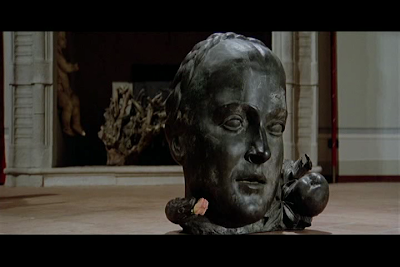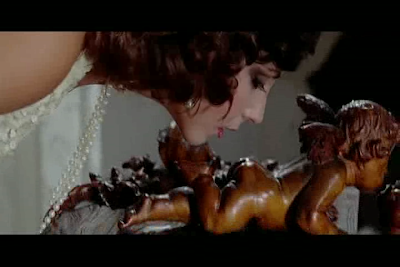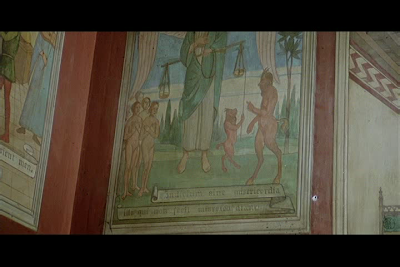The Biedermeier Reich - Red Nights of the Gestapo (Fabio De Agostini, 1977)
In the early 1950s Minnie & I visited Mexico many times, often to share our dark sacraments with the obscure coven nurtured by the writer D. H. Lawrence during the 1920s & sometimes simply to bask in the community of shadowy European exiles in the area surrounding Lake Chapala & Oaxaca. It was a colorful network of deposed aristocrats, a distinctly intellectual breed of pornographers, arms dealers, war profiteers & too many fugitive Nazis to count without effort. Something about the odd mixture of Christianity & paganism in their rugged adopted country seemed to strengthen the strand of Teutonic paganism already inherent in the National Socialist movement & add to it an obsessive fascination with all schools of occult practice.
The non-Aryan exiles of Lake Chapala & Taxco were well-versed in Grail mysticism, the art of the seance, all manner of divination & augury, cabalism, diabolism & hoodooistic bunkum, giving the old Nazis a virtual department store of secret knowledge to explore & integrate with their own beliefs. Seances to invoke the spirits of Hitler, Goebbels & Himmler were common in the hotels & haciendas of the resort, often performed poolside at midnight, with wraiths of sulfurous steam rising from the spring-fed grottoes & setting off across the beautiful green lawns to weave among the citrus trees, gigantic night-blooming flowers & bungalows, while the parrots & iguanas perched on the branches, frozen into marvelously colored statuary by the spirits which coursed, often visibly, through the muggy late evening air.
What brought this to mind was the furniture and other decor used in the Nazi-oriented exploitation film, Red Nights of the Gestapo. The Nazi officers who felt assured enough of their safety to purchase sprawling hacienda-style ranches in the hill country had somehow managed to either smuggle surprising amounts of furniture & art out of Germany when they fled that country, or purchase Black Forest & Biedermeier treasures from countrymen who'd settled in Mexico during the turn of the century & following World War I. This led to a peculiar confluence of styles. The spacious, sparely-furnished ranch houses were washed -- the word "painted" seems far too formal in this context -- in an unbelievably wide spectrum of bleached skeleton colors & earthen umber, but the Nazis changed the decors drastically to approximate the hunting lodges & country houses of the Fatherland. Hoary animal heads & heavy, dark Linden wood armoires replaced the easy flow of cattle skulls & Pre-Columbian jaguar & mythical bird figures stolen from the Teotihuacan pyramids in the volcano basin near Mexico City.
Huge painted portraits of ancestors & fallen comrades were hung awkwardly on walls best suited for collections of small religious icons & seemed to devour entire areas of the house with their stern colonial demeanors. These mustached, swirling, oil-painted visages were larger than most of the Mexicans who worked for the Nazis & when the gardeners, horse trainers, au pairs & maids were forced to cross these rooms with great shaggy bearded goats on one wall & white-haired officers from the Franco-Prussian War, their chests a conflagration of medals & ribbons, on the other, they invariably cowered as they went.
This story may seem a little off-course & on the surface has little to do with the still photographs from Red Nights, but it reveals all Minnie & I know of Nazis & therefore may explain our interest in the furnishings, tapestries & objets d'art depicted here. Ave, Lucifer, my dear friends.
The non-Aryan exiles of Lake Chapala & Taxco were well-versed in Grail mysticism, the art of the seance, all manner of divination & augury, cabalism, diabolism & hoodooistic bunkum, giving the old Nazis a virtual department store of secret knowledge to explore & integrate with their own beliefs. Seances to invoke the spirits of Hitler, Goebbels & Himmler were common in the hotels & haciendas of the resort, often performed poolside at midnight, with wraiths of sulfurous steam rising from the spring-fed grottoes & setting off across the beautiful green lawns to weave among the citrus trees, gigantic night-blooming flowers & bungalows, while the parrots & iguanas perched on the branches, frozen into marvelously colored statuary by the spirits which coursed, often visibly, through the muggy late evening air.
What brought this to mind was the furniture and other decor used in the Nazi-oriented exploitation film, Red Nights of the Gestapo. The Nazi officers who felt assured enough of their safety to purchase sprawling hacienda-style ranches in the hill country had somehow managed to either smuggle surprising amounts of furniture & art out of Germany when they fled that country, or purchase Black Forest & Biedermeier treasures from countrymen who'd settled in Mexico during the turn of the century & following World War I. This led to a peculiar confluence of styles. The spacious, sparely-furnished ranch houses were washed -- the word "painted" seems far too formal in this context -- in an unbelievably wide spectrum of bleached skeleton colors & earthen umber, but the Nazis changed the decors drastically to approximate the hunting lodges & country houses of the Fatherland. Hoary animal heads & heavy, dark Linden wood armoires replaced the easy flow of cattle skulls & Pre-Columbian jaguar & mythical bird figures stolen from the Teotihuacan pyramids in the volcano basin near Mexico City.
Huge painted portraits of ancestors & fallen comrades were hung awkwardly on walls best suited for collections of small religious icons & seemed to devour entire areas of the house with their stern colonial demeanors. These mustached, swirling, oil-painted visages were larger than most of the Mexicans who worked for the Nazis & when the gardeners, horse trainers, au pairs & maids were forced to cross these rooms with great shaggy bearded goats on one wall & white-haired officers from the Franco-Prussian War, their chests a conflagration of medals & ribbons, on the other, they invariably cowered as they went.
This story may seem a little off-course & on the surface has little to do with the still photographs from Red Nights, but it reveals all Minnie & I know of Nazis & therefore may explain our interest in the furnishings, tapestries & objets d'art depicted here. Ave, Lucifer, my dear friends.






















Comments
Post a Comment